Lisa Sachs's Blog, page 8
April 14, 2016
How to Explain the History of Communism to Mental Patients"
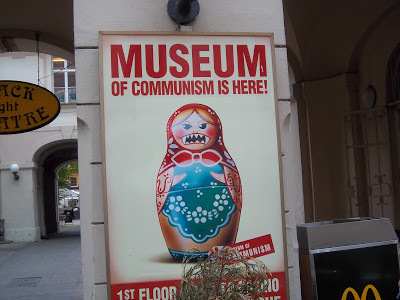
That’s the title for the current play at the Trapdoor Theatre, one of our favorite Chicago theatre groups. They perform at 1655 W. Cortland in Chicago and were incorporated in 1994.The Trapdoor does an outstanding job of presenting Eastern European content plays in English. Each year, the group travels to an Eastern Europe country staying with theatre people there and getting rejuvenated with fresh ideas. Remarkably, all the actors have full-time day jobs and perform gratis. That considered, it’s remarkable what a fine acting job they do.
Many of Trapdoor’s plays have a similar style. Due to the repression the former Iron Curtain countries endured prior to 1989, their writers had to adapt, expressing their ideas in allegory, symbolism, fairy tales, fantasy, abstractions, and theatre of the absurd. Anything but what they really wanted to say was okay. It’s always a challenge figuring out what each of the elements in the play really represents.
Last week we saw “How to Explain the History of Communism to Mental Patients.” This outstanding piece of theatre was written by Matei Visniec and directed by Zoltan Balazs. As the first scene opens, the writer Yuri Petrovski has been brought to the psychiatric hospital so that he can write a poetic account of the glories of Communism, its history, and its leaders. Will the patients be uplifted by his poetic writings or will the patients ensnarl him in their various pathologies? I leave it to you the audience to find out. The play will be performed through April 16th. If you live in the Chicago area, I suggest that you take it in. If you live elsewhere, watch for this play to be performed in your area.
All the Trapdoor Theatre’s plays have resonated with us even more since visiting Prague and other points in Eastern Europe. While there, we visited The Museum of Communism probably more aptly named The Museum of the Soviet Occupation of Czechoslovakia. A picture of a Russian nesting doll with huge fangs greets people with on the poster “Entrance to the Museum of Communism is Here.” The picture largely sums up the attitudes of these countries to that period of their history.
Sometimes traveling elsewhere helps us to appreciate what we have here in the United States. We’re lucky to have never experienced what they have and I hope we never have to. Go see “How to Explain the History of Communism to Mental Patients.” You’ll see what I mean.
Published on April 14, 2016 06:00
April 7, 2016
Chicago Rated 140 Out of 150 In Recreational Activities for Retirees. Really!
One of the things I love about traveling is coming home to Chicago and resuming all the activities that we do when we’re here. After all, that does take up the vast majority of our time. So I was really surprised when I read Dahleen Glanton’s column in the March 28th Chicago Tribune stating that Wallethub.com had rated Chicago the 144th out of 150 of cities in the United States in desirability for retirees to live.
Wallethub.com’s four criteria were affordability, quality of life, health care, and availability of recreational activities. I got the quality of life part. As everyone knows, our winters are brutally long and painfully cold. As for affordability, I could understand that as well. Although Chicago is considerably less expensive than the cities on either coast, it’s more expensive than many other cities in the middle of the country.
What I’m having difficulty with is the rating of 140 out of 150 in availability of recreational activities. Granted, if your only avocations are climbing mountains and downhill skiing, Chicago isn’t for you. It’s flat as a pancake. For anything else, I have trouble imagining anyplace with more things to do.
One category was volunteer activities for retirees. Chicago and most suburbs have websites listing all the volunteer opportunities. One thing I’ve observed is that when you’re willing to provide help for free, there’s never a lack of choices. I know people volunteering at the museums as docents, in the schools, in any number of socially minded causes, in the parks, and in the arts. My husband, for example, has enjoyed being a docent with the Chicago Architecture Foundation giving walking tours of Chicago’s buildings. I’ve found my volunteer niche tutoring immigrants in English. There are many places throughout the Chicago area to do this
In the arts, people living in Chicago are also blessed. We have many small and large theatre groups and music and dance venues as well. We belong to an organization The Saints that provides the opportunity to usher and volunteer at plays and other performances- there are over 100 venues- and then see the performance for free. It’s one of the best bargains in town. In the summer, the Chicago Civic Orchestra gives free concerts at Millenium Park. There are writers’ workshops at the libraries and other places.
As for classes, there are opportunities at the senior centers, park districts, community colleges, and some of the universities. Classes are available in everything from aerobics to Zen Buddhism. Some of the classes are for seniors only and some are for any adult. I love the variety that affords. Wallet hub was just using the amount of senior centers per capita as a measure.
I could go on and on about all the things there are to do here, but I have to go. I’m on my way to the Cultural Center to see a free art exhibit before meeting a friend for lunch. I have to get home in time because we’re ushering at a play tonight. I’ll talk to you about it later.
Wallethub.com’s four criteria were affordability, quality of life, health care, and availability of recreational activities. I got the quality of life part. As everyone knows, our winters are brutally long and painfully cold. As for affordability, I could understand that as well. Although Chicago is considerably less expensive than the cities on either coast, it’s more expensive than many other cities in the middle of the country.
What I’m having difficulty with is the rating of 140 out of 150 in availability of recreational activities. Granted, if your only avocations are climbing mountains and downhill skiing, Chicago isn’t for you. It’s flat as a pancake. For anything else, I have trouble imagining anyplace with more things to do.
One category was volunteer activities for retirees. Chicago and most suburbs have websites listing all the volunteer opportunities. One thing I’ve observed is that when you’re willing to provide help for free, there’s never a lack of choices. I know people volunteering at the museums as docents, in the schools, in any number of socially minded causes, in the parks, and in the arts. My husband, for example, has enjoyed being a docent with the Chicago Architecture Foundation giving walking tours of Chicago’s buildings. I’ve found my volunteer niche tutoring immigrants in English. There are many places throughout the Chicago area to do this
In the arts, people living in Chicago are also blessed. We have many small and large theatre groups and music and dance venues as well. We belong to an organization The Saints that provides the opportunity to usher and volunteer at plays and other performances- there are over 100 venues- and then see the performance for free. It’s one of the best bargains in town. In the summer, the Chicago Civic Orchestra gives free concerts at Millenium Park. There are writers’ workshops at the libraries and other places.
As for classes, there are opportunities at the senior centers, park districts, community colleges, and some of the universities. Classes are available in everything from aerobics to Zen Buddhism. Some of the classes are for seniors only and some are for any adult. I love the variety that affords. Wallet hub was just using the amount of senior centers per capita as a measure.
I could go on and on about all the things there are to do here, but I have to go. I’m on my way to the Cultural Center to see a free art exhibit before meeting a friend for lunch. I have to get home in time because we’re ushering at a play tonight. I’ll talk to you about it later.
Published on April 07, 2016 06:00
March 31, 2016
What Did You Do to the Jai Alai Games!
The first time my husband and I went to the jai alai games was in the 1970’s when we visited my grandmother in Miami, Florida. The stadium was full and the fans yelled encouragement to the players in English and Spanish. The game was exciting but the pageantry and the atmosphere surrounding the games was half the fun. At the beginning of each match, the teams would come to the front of the court accompanied by Spanish music. As they waved their cestas (baskets), the crowd would cheer. A night at the jai alai games was an event to look forward to.
As my family moved further north, we went to the frontons in Palm Beach and then in Dania near Fort Lauderdale. The atmosphere was still exciting.
The game of jai alai originated in the Basque region of Spain and many of the players still have Basque origins. Jai alai is played on what looks like an elongated handball court. About eight singles or doubles compete to see who can score the points first. They have to throw the pelota (ball) against the back and their opponent has to catch it on one bounce or on the fly. There is betting on which single or double will win. Each match lasts about 20 minutes. There are usually about 15 matches in an evening but one can come or go any time during the evening.
After years away from Florida, I was excited to go back to the jai alai games. We went to Dania, the closest fronton to where we were staying. The game is the same, but the pageantry and atmosphere are gone. Instead of being in a whole stadium, jai alai is now relegated to a small back room of a casino. Instead of a whole crowd being there to cheer, now there are only a few rows of people craning their necks to watch the matches. To add insult to injury, we had to plod through the casino to get to the jai alai room. What a disappointment!
 jai alai fronton in Dania, Florida
jai alai fronton in Dania, Florida
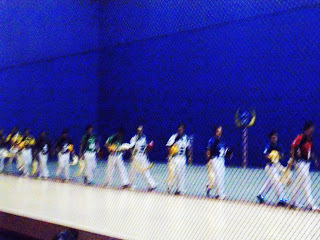 parade at the beginning of the match
parade at the beginning of the match
Apparently, jai alai has also been moved to a casino in Miami. I guess most people prefer the slot machines with their quick results. Maybe that’s collateral damage from all the time people spend playing video games. Click. Click. Click. I hope jai alai doesn’t go the way print newspapers seem to be going.
My new goal is to go to the Basque country- the Pyrenees Mountains of Spain and France- and see the jai alai games there. I think it will be really exciting.
playing jai alai in the Basque country
As my family moved further north, we went to the frontons in Palm Beach and then in Dania near Fort Lauderdale. The atmosphere was still exciting.
The game of jai alai originated in the Basque region of Spain and many of the players still have Basque origins. Jai alai is played on what looks like an elongated handball court. About eight singles or doubles compete to see who can score the points first. They have to throw the pelota (ball) against the back and their opponent has to catch it on one bounce or on the fly. There is betting on which single or double will win. Each match lasts about 20 minutes. There are usually about 15 matches in an evening but one can come or go any time during the evening.
After years away from Florida, I was excited to go back to the jai alai games. We went to Dania, the closest fronton to where we were staying. The game is the same, but the pageantry and atmosphere are gone. Instead of being in a whole stadium, jai alai is now relegated to a small back room of a casino. Instead of a whole crowd being there to cheer, now there are only a few rows of people craning their necks to watch the matches. To add insult to injury, we had to plod through the casino to get to the jai alai room. What a disappointment!
 jai alai fronton in Dania, Florida
jai alai fronton in Dania, Florida parade at the beginning of the match
parade at the beginning of the matchApparently, jai alai has also been moved to a casino in Miami. I guess most people prefer the slot machines with their quick results. Maybe that’s collateral damage from all the time people spend playing video games. Click. Click. Click. I hope jai alai doesn’t go the way print newspapers seem to be going.
My new goal is to go to the Basque country- the Pyrenees Mountains of Spain and France- and see the jai alai games there. I think it will be really exciting.
playing jai alai in the Basque country
Published on March 31, 2016 06:00
March 24, 2016
Climbing Florida's Mountains
To my surprise, we’ve found ourselves in South Florida for the past few winters. I say surprised because my parents lived there for 30 years. Before my parents moved there from New York, my grandparents and several other relatives lived there. Friends and colleagues would tell me about trips that they took to Mexico and the Caribbean Islands and I’d feel jealous that I was obligated to go to Florida to visit family instead.
When my mother became too fragile to live by herself in Florida, she moved to Boston to be near my sister. Thus, we were free to travel to any exotic place we wished. We were blessed to visit Costa Rica, Guatemala, and parts of South America. Those trips were fascinating and enjoyable. Nevertheless, I was shocked to find myself missing Florida anyway.
After a couple of months of enduring a Chicago winter each year, I find that I’m thrilled to go to Florida. As I told people on our trip to Guatemala, “We’re from Chicago. In February, I love anyplace with warm weather.” I always say that if the only sight I see in Florida is the Florida sunshine, I’ll be very happy. This year we were fortunate to have had great weather i.e. weather hot enough to go swimming and to spend a lot of time in the pool and at the beach.
Yes, Florida has sunshine, but it also has sunsets. They serve as a substitute for the mountains in this very flat state. This trip we saw some awesome sunsets.
 sunset in Hollywood Beach, Florida
sunset in Hollywood Beach, Florida
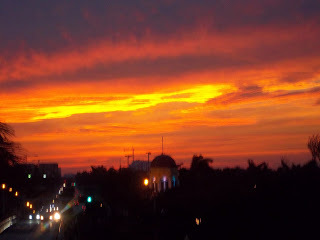
We’ve spent a lot of time in Hollywood Beach north of Miami and just south of Fort Lauderdale. This area is unique with its meld of pricey high rises on the beach and its art deco architecture from the 1920’s. On the beach, the Broadwalk stands out as a place to stroll along passing many restaurants, stores, and of course, a great variety of other people both locals and other vacationers while viewing the beach at the same time.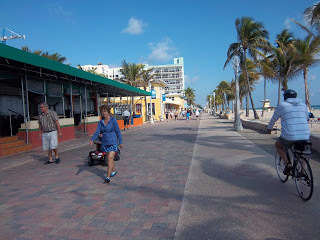 on the Hollywood Beach Broadwalk
on the Hollywood Beach Broadwalk
In town, the Young Circle and the downtown near it is being developed as an arts center. Cinema Paradiso, an indie movie theatre with 72 seats, was opened in 2013. The third Saturday of each month an art walk is held where artists open their studios to the public and musicians serenade the crowds outside of them. There are still only a few artists but the city is developing affordable housing with studios for artists to live in. Hopefully, as the area attracts more artists, this artwalk will grow. Cinema Paradiso in downtown Hollywood Beach
Cinema Paradiso in downtown Hollywood Beach
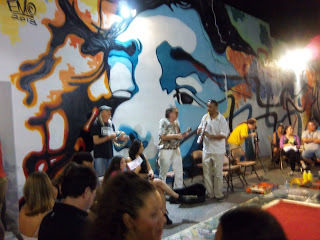 on the Artwalk in Hollywood Beach
on the Artwalk in Hollywood Beach
In recent years, there has been some gentrification in Hollywood Beach. When we came back this year, for example, a huge Margaritaville was added blocking many funky little 1920’s era motels from view. Locals hope that a balance can be struck that will allow locals who aren’t wealthy to stay there. Alas, this is an issue everywhere in the United States. I hope that the people of Hollywood Beach area can maintain its character allowing people of all income levels to enjoy it. My suggestion is that you see it soon just in case the character of it is lost in future years. We had a wonderful time there.
When my mother became too fragile to live by herself in Florida, she moved to Boston to be near my sister. Thus, we were free to travel to any exotic place we wished. We were blessed to visit Costa Rica, Guatemala, and parts of South America. Those trips were fascinating and enjoyable. Nevertheless, I was shocked to find myself missing Florida anyway.
After a couple of months of enduring a Chicago winter each year, I find that I’m thrilled to go to Florida. As I told people on our trip to Guatemala, “We’re from Chicago. In February, I love anyplace with warm weather.” I always say that if the only sight I see in Florida is the Florida sunshine, I’ll be very happy. This year we were fortunate to have had great weather i.e. weather hot enough to go swimming and to spend a lot of time in the pool and at the beach.
Yes, Florida has sunshine, but it also has sunsets. They serve as a substitute for the mountains in this very flat state. This trip we saw some awesome sunsets.
 sunset in Hollywood Beach, Florida
sunset in Hollywood Beach, Florida
We’ve spent a lot of time in Hollywood Beach north of Miami and just south of Fort Lauderdale. This area is unique with its meld of pricey high rises on the beach and its art deco architecture from the 1920’s. On the beach, the Broadwalk stands out as a place to stroll along passing many restaurants, stores, and of course, a great variety of other people both locals and other vacationers while viewing the beach at the same time.
 on the Hollywood Beach Broadwalk
on the Hollywood Beach BroadwalkIn town, the Young Circle and the downtown near it is being developed as an arts center. Cinema Paradiso, an indie movie theatre with 72 seats, was opened in 2013. The third Saturday of each month an art walk is held where artists open their studios to the public and musicians serenade the crowds outside of them. There are still only a few artists but the city is developing affordable housing with studios for artists to live in. Hopefully, as the area attracts more artists, this artwalk will grow.
 Cinema Paradiso in downtown Hollywood Beach
Cinema Paradiso in downtown Hollywood Beach on the Artwalk in Hollywood Beach
on the Artwalk in Hollywood BeachIn recent years, there has been some gentrification in Hollywood Beach. When we came back this year, for example, a huge Margaritaville was added blocking many funky little 1920’s era motels from view. Locals hope that a balance can be struck that will allow locals who aren’t wealthy to stay there. Alas, this is an issue everywhere in the United States. I hope that the people of Hollywood Beach area can maintain its character allowing people of all income levels to enjoy it. My suggestion is that you see it soon just in case the character of it is lost in future years. We had a wonderful time there.
Published on March 24, 2016 06:00
March 10, 2016
Traveling to America's Polar Regions
As has been said, America has become dangerously polarized. Many of us can’t talk to people who hold opposing political viewpoints. I have to admit that I’ve been guilty of that myself, but I felt that I was a step ahead of some of my Facebook friends when I saw this posting:
With just one click, you can find out which of your Facebook friends like Trump – and unfriend them.
I wondered why people would want to spy on their friends. After all, why stoop to Trump’s level? By now, we’ve all heard the stories of people quietly opposing his views being forcibly ejected from his rallies. His threats against anyone who opposes him are reported fully in all the media.
Then I wondered why they’d need to. I have a few Facebook friends who support Trump, but I hardly need to sign up for apps to find out which of my friends feel that way. They are posting pro Trump things on Facebook all the time. Then I wondered if most people only have friends who agree with them about everything. If we can’t even talk to our friends, how can we expect to have a dialog? How can we begin to solve all of America’s problems if we can’t even talk to each other?
In Better Off Without ‘Em, Chuck Thompson suggests that the North and South are so culturally and politically apart, it would be easier for both of us if we let the South secede. He presents his arguments with humor and anecdotes. At the end of his book, however, he gets serious and admits that the likelihood of this happening is remote at best.
Since we’re all forced to be one country, instead of unfriending each other, we’d be better off trying to listen to each other and find out where we’re all coming from. The dichotomies aren’t only between the North and South, but are also between the socially conservative and those who are more open-minded, between upper classes and people who struggle from paycheck to paycheck, between racial and ethnic groups. It will be hard to talk about issues we’ve all been yelling about but in the end, it may be worth it. So if anyone reading this is pro Trump, I invite you to tell me why. Maybe you have a good reason, but I can’t see it for the life of me. Anyone who’s definitely for any other candidate, you’re invited to put your 2cents in also. I won’t edit what anyone says unless swear words, pornography, or personal insults are used. We’re poles apart and we need to start talking now before it’s too late.
With just one click, you can find out which of your Facebook friends like Trump – and unfriend them.
I wondered why people would want to spy on their friends. After all, why stoop to Trump’s level? By now, we’ve all heard the stories of people quietly opposing his views being forcibly ejected from his rallies. His threats against anyone who opposes him are reported fully in all the media.
Then I wondered why they’d need to. I have a few Facebook friends who support Trump, but I hardly need to sign up for apps to find out which of my friends feel that way. They are posting pro Trump things on Facebook all the time. Then I wondered if most people only have friends who agree with them about everything. If we can’t even talk to our friends, how can we expect to have a dialog? How can we begin to solve all of America’s problems if we can’t even talk to each other?
In Better Off Without ‘Em, Chuck Thompson suggests that the North and South are so culturally and politically apart, it would be easier for both of us if we let the South secede. He presents his arguments with humor and anecdotes. At the end of his book, however, he gets serious and admits that the likelihood of this happening is remote at best.
Since we’re all forced to be one country, instead of unfriending each other, we’d be better off trying to listen to each other and find out where we’re all coming from. The dichotomies aren’t only between the North and South, but are also between the socially conservative and those who are more open-minded, between upper classes and people who struggle from paycheck to paycheck, between racial and ethnic groups. It will be hard to talk about issues we’ve all been yelling about but in the end, it may be worth it. So if anyone reading this is pro Trump, I invite you to tell me why. Maybe you have a good reason, but I can’t see it for the life of me. Anyone who’s definitely for any other candidate, you’re invited to put your 2cents in also. I won’t edit what anyone says unless swear words, pornography, or personal insults are used. We’re poles apart and we need to start talking now before it’s too late.
Published on March 10, 2016 06:00
March 3, 2016
An "Anthropologist on Mars" Views Super Tuesday's Returns
 The Scream by Edvard Munch. Yes, I feel like screaming too. Yikes!As you all know, Temple Grandin, who is autistic, is the famous animal husbandry expert. She has not only innovated many changes in her field, but has also been a spokesperson for autism. She’s written several books about autism that translate the autistic experience to those of us who aren’t autistic.
The Scream by Edvard Munch. Yes, I feel like screaming too. Yikes!As you all know, Temple Grandin, who is autistic, is the famous animal husbandry expert. She has not only innovated many changes in her field, but has also been a spokesperson for autism. She’s written several books about autism that translate the autistic experience to those of us who aren’t autistic.Temple Grandin has likened her experience of the world of emotion and human relationships to feeling like an “Anthropologist on Mars.” I have to empathize with Ms. Grandin because sometimes I feel like an “Anthropologist on Mars” myself. Yesterday watching the Super Tuesday primary election returns coming in was a great example.
I often say that I’m technologically challenged. I don’t have a Smart Phone and don’t know how to text. As a matter of fact, I had to enlist the assistance of a computer savvy friend to start this blog. At this point, Temple Grandin is probably better equipped than I am to understand current communication methods and probably understands current campaign styles better than I do.
Candidates have twitter accounts, Facebook pages, and give us their views in 140 characters. People watch for gotcha moments on television and a lot of people have been deciding how to vote on that basis.
I watched the Republican debates aghast to see the candidates explaining their positions on complicated issues in the minute or two they each had allotted to them. In subsequent debates, this descended into mutual name-calling. It seems that Americans are picking their candidate the way they pick American Idol or a Survivor winner. It’s no wonder Donald Trump is shaping up as the front runner. He is very adept at tapping into voters’ anger in two-minute sound bites. I wonder how Pres. Lincoln would have done in this format. After all, he was a Republican, too.
Pretty soon I have to vote in the Illinois Democratic Primary. Will it be Hillary or will I feel the Bern? Do Bernie Sanders’ supporters like him because he reminds them of their grandfathers and makes them feel cared for or have they suddenly developed class-consciousness and become Socialists? Will enough Americans be able to get past their customary revulsion to the word Socialist to vote for a Socialist Jew from New York for him to win the election? Or will Hillary be able to adapt to the world of sound bites and social media in time to be a strong candidate? Or are enough Americans going to be so horrified by Trump’s bullying Nazi tactics to vote for anyone opposing him? Will my vote matter? I don’t know, but I’m joining Temple Grandin as an Anthropologist on Mars. Who knows? Maybe I’ll move there if Donald Trump becomes President.
If anyone has any insight to the current American mood, please clue me in. I’m looking forward to hearing your opinion. You don’t have to limit yourself to 140 characters either.
Published on March 03, 2016 06:00
February 18, 2016
Visiting the Mitchell Museum of the American Indian
I wanted to take my granddaughters to the Mitchell Museum of the American Indian, but they seemed disinterested. “They’re having a fashion show of Indian clothes,” I told them.
This got their attention and they were ready to leave within minutes. I was simply following an old social work adage to meet people where they’re at. Right now, alas, that is where they are.
The Mitchell Museum of the American Indian www.mitchellmuseum.org is located at 3001 Central Avenue in Evanston, Illinois. This small museum has many native artifacts and artwork. Although the building is small, there is usually something new to see there because they change their exhibits often. There are also usually some exhibits that invite interaction making it a good place to take children. If you check their website, you can see their schedule of interactive art projects. The exhibit on Indian fashion opened in January and will be there through May.
We enjoyed popping in and out of the tepee that is there permanently. I have to say that it’s much easier for a five year old or seven year old to do that than it was for me.
The exhibits of outfits, beadwork, and other jewelry were impressive and we enjoyed looking at them as well.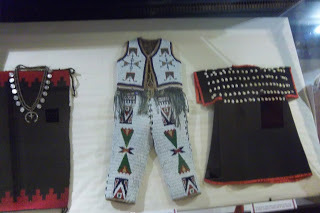
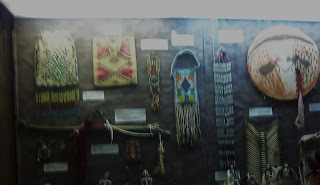
At the end of the exhibit, there is a place for would-be fashion designers to fashion their own designs and display them. Near that is a sign discussing assimilation and separation as it applies to fashion.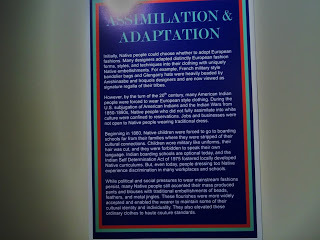
It would have been interesting to discuss that with my three granddaughters who dress in Orthodox Jewish fashion. I’d love an opportunity to arrange a meeting of Native Americans and Orthodox Jews to discuss the issue. Maybe someday we’ll get that opportunity. In the meantime, I’m glad that I had a chance to see the exhibit with my granddaughters. If you have an hour, I suggest that you visit there, too.
t
This got their attention and they were ready to leave within minutes. I was simply following an old social work adage to meet people where they’re at. Right now, alas, that is where they are.
The Mitchell Museum of the American Indian www.mitchellmuseum.org is located at 3001 Central Avenue in Evanston, Illinois. This small museum has many native artifacts and artwork. Although the building is small, there is usually something new to see there because they change their exhibits often. There are also usually some exhibits that invite interaction making it a good place to take children. If you check their website, you can see their schedule of interactive art projects. The exhibit on Indian fashion opened in January and will be there through May.
We enjoyed popping in and out of the tepee that is there permanently. I have to say that it’s much easier for a five year old or seven year old to do that than it was for me.

The exhibits of outfits, beadwork, and other jewelry were impressive and we enjoyed looking at them as well.


At the end of the exhibit, there is a place for would-be fashion designers to fashion their own designs and display them. Near that is a sign discussing assimilation and separation as it applies to fashion.

It would have been interesting to discuss that with my three granddaughters who dress in Orthodox Jewish fashion. I’d love an opportunity to arrange a meeting of Native Americans and Orthodox Jews to discuss the issue. Maybe someday we’ll get that opportunity. In the meantime, I’m glad that I had a chance to see the exhibit with my granddaughters. If you have an hour, I suggest that you visit there, too.
t
Published on February 18, 2016 06:00
February 11, 2016
My Mother's Journey
Last week we made an expected trip to Florida for my mother June Rosenberg’s funeral. Although it was expected because she was 94 years old and had an incurable heart condition, whenever you receive The Call, it’s always a shock.
My mother was born in Brooklyn, New York and was a talented artist. She attended Washington Irving High School when it was the art high school in those days before The High School of Music and Art was opened. After that, she finished a program at the Parsons School of Design and then attended classes at the Art Students League both in Manhattan. Her walls were full of her paintings and she worried what would become of them when she passed away as if they were her children. In a way, I guess they were. We'd try to calm her while inwardly I'd be struggling to imagine where I'd put all of them. "There'll be a place for all of them," I'd tell her.
I could talk about all the loving things that most parents do. My mother did them for sure. What made my childhood somewhat distinctive, however, was my parents’ political activism. To this day, it is the lodestar that shapes my life and dictates what I do and how I live.
My parents June and Jack Rosenberg got married right after World War II on September 22, 1946 and always had a wonderful relationship. We moved to Long Island in 1951 and they were active there in the Comm. for a Sane Nuclear Policy, the Civil Rights movement, and several other social-economic justice causes. During the era of crouching under school desks during air-raid drills, I was happy to tell my friends that my parents were in Sane.
One thing I am most proud of my parents for is founding a Fair Housing Committee with a few other couples in our Long Island suburb to promote it becoming racially integrated. This was not a popular idea at the time -far from it, but they knew it was the right thing to do. As a teenager, I went with them to many civil rights rallies and marches. One of my friends at the time would say that when I became a parent, I would have to give my children something I never had - something to rebel against. I remember my mother laughing at that.
My parents moved to Florida to retire and my mother loved being there. She moved to Brookline, Massachusetts in 2009 to be near my sister albeit reluctant to leave the Florida sunshine and quickly embraced her new community. We knew she was accepting the move when she wrote up petitions and got them signed for the Affordable Care Act.
At the end of her life, when my mother had mobility problems, her activism was confined to writing letters to The Boston Globe most of which got published. I’d have people take pictures of me whenever I attended any anti-war or social justice event and then I’d send the pictures to her. She’d always say, “It makes me feel good. You were there for both of us.”
June Rosenberg was interested in the world throughout her life. My parents didn’t have money to pass down to me, but I inherited my mother’s AFSCME (American Federation of State, County, and Municipal Employees) pen. I’ll think about her every time I use it. I’ll have to keep doing it for both of us.
To see my mother’s recipes, visit my blog Recipes for a Better World http://www.recipesforabetterworld.blogspot.com. Or better yet, read my book Breaking the Fall available on Amazon as a Kindle or paperback. You’ll find her between the lines.
My mother was born in Brooklyn, New York and was a talented artist. She attended Washington Irving High School when it was the art high school in those days before The High School of Music and Art was opened. After that, she finished a program at the Parsons School of Design and then attended classes at the Art Students League both in Manhattan. Her walls were full of her paintings and she worried what would become of them when she passed away as if they were her children. In a way, I guess they were. We'd try to calm her while inwardly I'd be struggling to imagine where I'd put all of them. "There'll be a place for all of them," I'd tell her.
I could talk about all the loving things that most parents do. My mother did them for sure. What made my childhood somewhat distinctive, however, was my parents’ political activism. To this day, it is the lodestar that shapes my life and dictates what I do and how I live.
My parents June and Jack Rosenberg got married right after World War II on September 22, 1946 and always had a wonderful relationship. We moved to Long Island in 1951 and they were active there in the Comm. for a Sane Nuclear Policy, the Civil Rights movement, and several other social-economic justice causes. During the era of crouching under school desks during air-raid drills, I was happy to tell my friends that my parents were in Sane.
One thing I am most proud of my parents for is founding a Fair Housing Committee with a few other couples in our Long Island suburb to promote it becoming racially integrated. This was not a popular idea at the time -far from it, but they knew it was the right thing to do. As a teenager, I went with them to many civil rights rallies and marches. One of my friends at the time would say that when I became a parent, I would have to give my children something I never had - something to rebel against. I remember my mother laughing at that.
My parents moved to Florida to retire and my mother loved being there. She moved to Brookline, Massachusetts in 2009 to be near my sister albeit reluctant to leave the Florida sunshine and quickly embraced her new community. We knew she was accepting the move when she wrote up petitions and got them signed for the Affordable Care Act.
At the end of her life, when my mother had mobility problems, her activism was confined to writing letters to The Boston Globe most of which got published. I’d have people take pictures of me whenever I attended any anti-war or social justice event and then I’d send the pictures to her. She’d always say, “It makes me feel good. You were there for both of us.”
June Rosenberg was interested in the world throughout her life. My parents didn’t have money to pass down to me, but I inherited my mother’s AFSCME (American Federation of State, County, and Municipal Employees) pen. I’ll think about her every time I use it. I’ll have to keep doing it for both of us.
To see my mother’s recipes, visit my blog Recipes for a Better World http://www.recipesforabetterworld.blogspot.com. Or better yet, read my book Breaking the Fall available on Amazon as a Kindle or paperback. You’ll find her between the lines.
Published on February 11, 2016 06:00
January 28, 2016
Behind the Veil Is A Human Being
My daughter, three granddaughters, and I were getting ready to leave the walking track at Weber Park when she walked past. Because she was covered completely from head to toe and wore a black veil covering everything except her eyes, my granddaughters stared at her curiously. Living in an observant Jewish neighborhood, they had never seen anyone dressed that way. Observing their stares, the woman turned around and removed her veil. Behind it was a beautiful young woman. Smiling, she said to my granddaughters, “I wear this because it is part of my religion not to show my face to men.”
“Your face is very pretty,” said my youngest granddaughter.
She went on to explain that she could show her face to her husband, father, brothers, sons, and her grandfathers. Otherwise, her face must be covered in the presence of men as protection for her.
My daughter explained that Orthodox Jews have the same rules and concepts although their rules only apply to hair not to the face.
“It’s interesting how people can come from different places and end up at the same idea,” I said.
While I don’t subscribe to any religious beliefs that lead to women being restricted, her removing her veil and letting us see her face made her particular beliefs much less threatening. Indeed, the moment when she removed her veil for us was a special one for all of us; and thus, one veil at a time, some animosity was stripped away.
“Your face is very pretty,” said my youngest granddaughter.
She went on to explain that she could show her face to her husband, father, brothers, sons, and her grandfathers. Otherwise, her face must be covered in the presence of men as protection for her.
My daughter explained that Orthodox Jews have the same rules and concepts although their rules only apply to hair not to the face.
“It’s interesting how people can come from different places and end up at the same idea,” I said.
While I don’t subscribe to any religious beliefs that lead to women being restricted, her removing her veil and letting us see her face made her particular beliefs much less threatening. Indeed, the moment when she removed her veil for us was a special one for all of us; and thus, one veil at a time, some animosity was stripped away.
Published on January 28, 2016 06:00
January 21, 2016
"A House Divided Against Itself Cannot Stand."
These immortal words of President Lincoln are still true today in our polarized environment. Ever since the Abraham Lincoln Presidential Museum www.lincolnlibraryandmuseum.comopened in 2004, we had been talking about taking a trip to Springfield, Illinois to visit it.
When we received an offer from Travel Zoo (www.travelzoo.com), it seemed like the right time to make the trip. Travel Zoo offered a package for $89 that included a room in the Statehouse Inn Hotel, admission for two to the museum, breakfast, a $10 off voucher for dinner at Arlington’s, a restaurant a three minute walk away, and complementary drinks at the bar in the hotel.
Travel Zoo’s deal was definitely a good one. Even without it, however, The Abraham Lincoln Presidential Museum and Library is worth a trip especially if you live in the Chicago area. From the north side of Chicago, it’s a three and a half hour car trip. Also, Amtrak goes to Springfield from Union Station in Chicago. The station in Springfield is a short walk from the Statehouse Inn.
For those who have never been to Springfield there are several interesting historic sites to see there including Lincoln’s home and historic area, his old law offices, the old Capitol Building, and the original train depot. In addition, the State of Illinois Museum is worth seeing. The Abraham Lincoln Presidential Library and Museum contains some wonderfully interactive exhibits as well as exhibits illustrating many periods of Lincoln’s life. The Museum and Library also houses many original document and artifacts.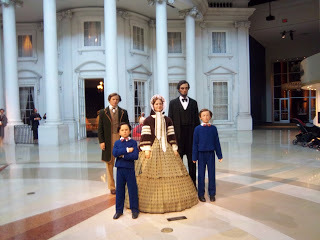 replica of Lincoln family in the lobby of the museum
replica of Lincoln family in the lobby of the museum

As we came in, we were directed to a short film “The Ghost in the White House” that explained on a very accessible level how historians combed through documents and various artifacts to get a better idea of historical events. The use of holograms and some theatrics made this topic come alive. Other exhibits traced the progression of slavery as an issue and Lincoln’s own evolution throughout his career and during the Civil War leading to his issuing The Emancipation Proclamation.
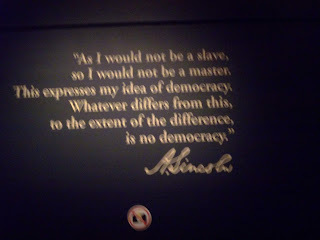
Another exhibit done by the journalist Tom Russert “The Campaign of 1860” juxtaposes modern 21st century campaign techniques on the Presidential campaign of 1860. This exhibit gives us all a lot to think about. If Lincoln ran for President in 2016, would he stand any chance of winning? The Republican Party probably wouldn’t consider him Conservative enough. TV and other media might not consider him attractive and telegenic enough to be worth getting much coverage. As a poor boy who was largely self-educated, he would have lacked the elite alumni connections of to a prestigious university. He wouldn’t have had enough of his own money to finance a campaign and may have been too humble to raise huge donations. Fortunately, the United States of America and the world are blessed that Lincoln was President during the 1860’s. I hate to think how history would have unfolded without him in the White House.
When we received an offer from Travel Zoo (www.travelzoo.com), it seemed like the right time to make the trip. Travel Zoo offered a package for $89 that included a room in the Statehouse Inn Hotel, admission for two to the museum, breakfast, a $10 off voucher for dinner at Arlington’s, a restaurant a three minute walk away, and complementary drinks at the bar in the hotel.
Travel Zoo’s deal was definitely a good one. Even without it, however, The Abraham Lincoln Presidential Museum and Library is worth a trip especially if you live in the Chicago area. From the north side of Chicago, it’s a three and a half hour car trip. Also, Amtrak goes to Springfield from Union Station in Chicago. The station in Springfield is a short walk from the Statehouse Inn.
For those who have never been to Springfield there are several interesting historic sites to see there including Lincoln’s home and historic area, his old law offices, the old Capitol Building, and the original train depot. In addition, the State of Illinois Museum is worth seeing. The Abraham Lincoln Presidential Library and Museum contains some wonderfully interactive exhibits as well as exhibits illustrating many periods of Lincoln’s life. The Museum and Library also houses many original document and artifacts.
 replica of Lincoln family in the lobby of the museum
replica of Lincoln family in the lobby of the museum
As we came in, we were directed to a short film “The Ghost in the White House” that explained on a very accessible level how historians combed through documents and various artifacts to get a better idea of historical events. The use of holograms and some theatrics made this topic come alive. Other exhibits traced the progression of slavery as an issue and Lincoln’s own evolution throughout his career and during the Civil War leading to his issuing The Emancipation Proclamation.

Another exhibit done by the journalist Tom Russert “The Campaign of 1860” juxtaposes modern 21st century campaign techniques on the Presidential campaign of 1860. This exhibit gives us all a lot to think about. If Lincoln ran for President in 2016, would he stand any chance of winning? The Republican Party probably wouldn’t consider him Conservative enough. TV and other media might not consider him attractive and telegenic enough to be worth getting much coverage. As a poor boy who was largely self-educated, he would have lacked the elite alumni connections of to a prestigious university. He wouldn’t have had enough of his own money to finance a campaign and may have been too humble to raise huge donations. Fortunately, the United States of America and the world are blessed that Lincoln was President during the 1860’s. I hate to think how history would have unfolded without him in the White House.
Published on January 21, 2016 06:00



